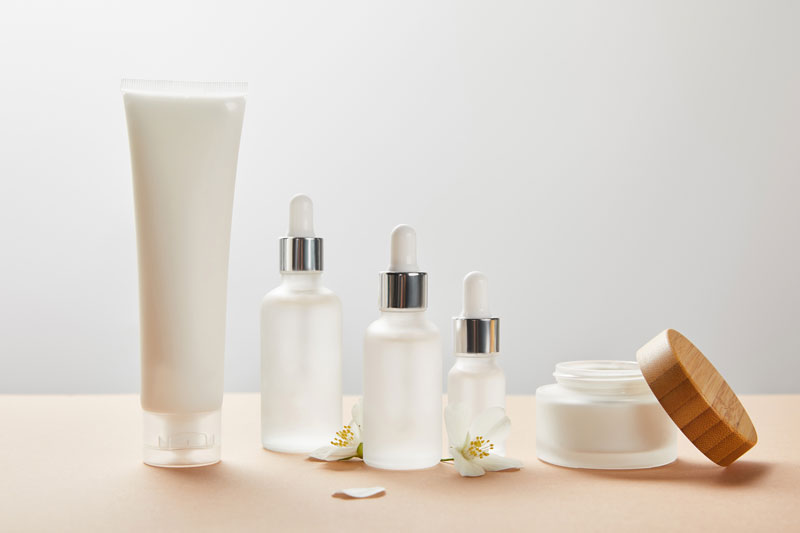Just because we use serums and moisturizers on the outside doesn’t mean they don’t affect our insides. Skincare products are topical, but their impact goes beyond that—affecting our endocrine system, reproductive system, and more! In this article, we’re sharing the most common hormone disruptors in skincare. Learn about the products that are causing hormone imbalances and leading to a whole host of other problems you may be experiencing.
How Skin Care Products Impact Our Bodies
When we apply our daily serum or foundation onto our skin, their ingredients leech into our skin and absorb into our bloodstream. I mean, think about it. Why else would we use a product if it didn’t absorb into our skin?
The problem is that most skincare products on the market are overflowing with artificial chemicals and harsh toxins that have been linked to infertility, inflammation, and even cancers.
TRUTH BOMB:
You’re
Already killing it!
If You Were More Consistent With Your Wellness Routine, You’d Be Unstoppable.
At the root of this are endocrine disruptors or xenoestrogens. We’ve talked about it before, and we will surely talk about it again. Conventional cosmetics and skincare products with promises of turning back the clock contain estrogen-mimicking chemicals that send our estrogen levels through the roof, setting off a whole host of chain reactions.
Estrogen dominance is already incredibly common among both men and women, thanks to the toxic food system. When we add chemicals from skin care, we just make matters worse. Here are some of the risks associated with high estrogen levels and endocrine disruptors:
- Mood swings
- Depression
- Anxiety
- Heavy periods
- Uterine fibroids
- Endometriosis
- Hormonal migraines
- Hypothyroidism
- Heart disease, stroke, clotting problems
- Breast, ovarian, and endometrial cancer
- And more
Hormone Disruptors in Skincare to Steer Clear of
Fragrance
Fragrance isn’t just one thing—although that’s how it appears on just about any product that has a scent. According to the FDA, fragrance is a “traded secret” and can be a blend formulated from any of the 3,000 approved dangerous chemicals. Many of these ingredients are phthalates which contribute to hormone disruption, decreased levels of sex hormones, insulin resistance, and other risks associated with the reproductive system.
If fragrance is listed in your skincare product, assume that it’s synthetic and not natural. Natural fragrances will usually be listed, for example, as rose essential oil etc.
Parabens
You’ve probably seen “paraben-free” on a ton of skincare products recently, and for a good reason. Although companies are taking the hint, parabens are commonly used as preservatives in a lot of cosmetics. Parabens have been found in breast cancer tumors and are linked to endocrine disruption. When our endocrine system gets all out of whack, we increase our risk for infertility, PMS issues, brain fog, sexual development, and more.
Look for any words on your ingredient with the word “paraben” in them, or look for words that begin with “ethyl,” “butyl,” “methyl, or “propyl”. Let’s look at one of these common parabens below.
Butylated Hydroxyanisole (BHA)
BHA, a common preservative and paraben used in cosmetics and pharmaceuticals, is classified as an endocrine-disrupting chemical. While it’s banned across Europe, it is still found in many products in America. In animal studies, BHA altered the reproductive health and thyroid regulation in subjects.
Triclosan
Even the FDA has criticized triclosan for its hormone-disrupting properties. Short term animal studies have shown that exposure to high doses of triclosan is linked to decreased levels of some thyroid hormones. Here’s the thing though, small, consistent use of an ingredient can lead to high doses. Just because you’re not dosing a high amount everyday, doesn’t mean it won’t have an impact.
Formaldehyde-releasing ingredients
The same toxic-smelling chemical used to preserve dead bodies and your science-experiment frog might be hiding in your skincare. Formaldehyde is a known carcinogen and something we should avoid at all costs.
While companies don’t typically use the ingredient directly, they will use chemicals that when combined, release formaldehyde. Here are the ingredients to look out for:
- DMDM hydantoin
- Imidazolidinyl urea
- Diazolidinyl urea
- Quaternium-15
- Bronopol (2-bromo-2-nitropropane-1,3-diol )
- 5-Bromo-5-nitro-1,3-dioxane
- Hydroxymethylglycinate
- Sodium hydroxymethylglycinate
Skincare products in plastic
While this one may be harder to avoid, BPA is a massive health hazard that contributes to estrogen dominance. Opt for skincare products in glass bottles. These days, it’s much easier to find trustworthy and values-based skincare companies that are combining healthy botanical products in glass tinctures and containers. If you can’t avoid plastic packaging, make sure to keep your products out of the heat as heat releases endocrine-disrupting chemicals.
As you can see, conventional skincare products that contain these sneaky ingredients should be avoided at all costs. Keeping your eye out for these ingredients will help keep your hormones in check. When our hormones are balanced not only is our mood and overall wellness better, but our skin looks better.
To discover organic brands we love sans hormone disruptors, check out these articles:
Sources
- “Carcinogens in Cosmetics.” Safe Cosmetics. Retrieved from: http://www.safecosmetics.org/get-the-facts/chemicals-of-concern/known-carcinogens/
- Christiane Northrup, M.D., (2018). What Are the Symptoms of Estrogen Dominance? Retrieved from: https://www.drnorthrup.com/estrogen-dominance/





READ the Latest
Health Habits
Longevity
Health Habits
Health Habits